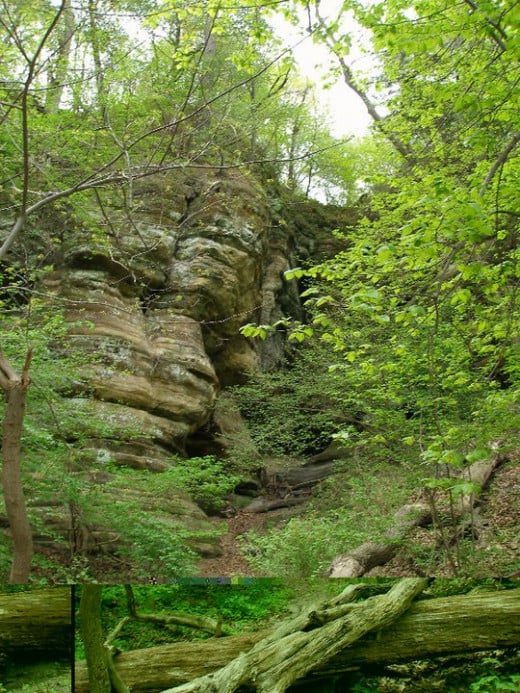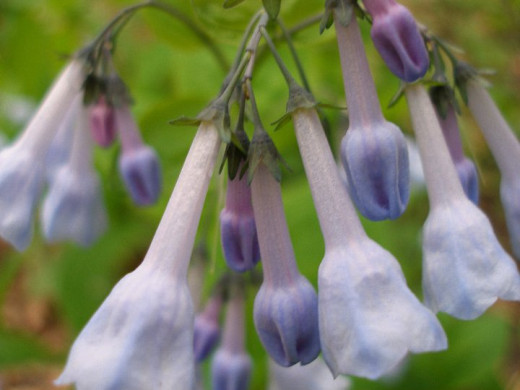Garden Spotlight: The Woodland Garden
A Lovely Spring Day in May
For native garden design inspiration, I always try to take a nature hike in spring.
This article's focus is on Starved Rock State Park in lovely Utica, IL where sandstone bluffs were formed millions of years ago along the Illinois River. This diverse woodland is home to over 200 types of wildflowers and plants, as well as various wildlife like Bald Eagles (December through March) and a large population of Pelicans. The park is about 90 miles southwest of downtown Chicago. It is also home to 18 canyons; 14 of which have waterfalls (only if adequate rainfall has happened recently).
History of Starved Rock
- Park History - Starved Rock State Park
Official Website

A Walk in the Woods
Starved Rock is a great place to see breathtaking views and get in some good exercise as well. It seems there is something for everyone here; canyons, trails, river views, bluffs and of course, plants. Many of the plants you will find featured in this article can be grown in your home garden, especially if the same conditions are met.
Some of these conditions are:
- Light shade, dappled shade or part sun-some if not all these plants you are going to see are considered understory plants, meaning, they perform well planted under a tree or large shrub.
- Adequate moisture
A Note about Native Woodland Locations
Please respect any state park or forest preserve and do not remove plants for your own personal use unless authorized to do so by the State or City authority.
All of these plants can be found online for purchase. Or better yet, if you have a neighbor growing some of these, ask if you can have a cutting or a splitting.

Bluebells as Far as the Eye Can See
One of the great woodland plants are Virginia Bluebells. When in bloom (which happens in May) they produce spectacular color. When allowed to naturalize a space, they produce a sea of blue in an otherwise shady or uninteresting spot. I've see Bluebells in both full shade and full sun, so these plants are very versatile and not picky where they are planted. An area under a tree or in a shady border seems to be the best application. They do spread, so just be aware of that wherever you decide to plant them.


Wild Geranium: A Good Ground Cover
Geraniums come in all kinds of colors, but I find the most beautiful ones are located in the wild. Their lavender-pink flowers in Spring attract both bees and butterflies. Geraniums make a great ground cover and some varieties even have strongly scented leaves.

Jack-in-the-Pulpit: An Unusual Woodland Plant
A very unique and interesting plant, Jack-in-the-Pulpit grows well in deep shaded areas. It requires moist, hummus rich soil. In Spring is when you get the typical and identifiable pitcher-like flower. In the heat of summer, the plant transforms and produces an upright cluster of red berries attractive to wildlife. A wonderful specimen plant, it is best suited for that front of the border shady spot.

Trillium aka Wake Robin
Another interesting woodland plant is the Trillium. This native perennial naturalizes easily and takes part-shade. Like the Jack-in-the-Pulpit, it requires a moist, hummus-rich environment. Basically, mimicking the conditions present in the woods where it is found. Trillium come in a few different shades, but the most common are white, and the variegated with red blossom seen below.

Columbine
A beautiful, long-lived perennial that comes in many different shades is Columbine. This woodland flower has been bred and cultivated into a wide variety of colors, sizes and shapes. It is a great part-shade to part-sun flower that blooms late spring through early summer. The plants may die back if in too much sun and heat, but faithfully return every spring. They are slightly taller than the trillium and Jack-in-the-Pulpit, so can be placed in the middle of a border.

Nature's Diversity
This is just a small sampling of what your State Park or Forest Preserve has to offer in terms of wildflowers. Visit them often to see the ever changing landscape, as different plants bloom at different times in the year.

© 2014 Lisa Roppolo








